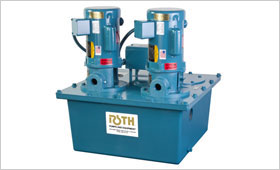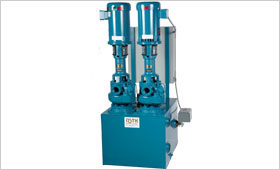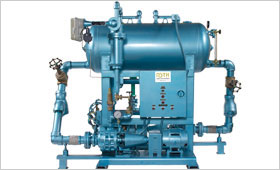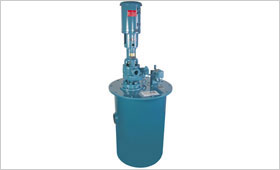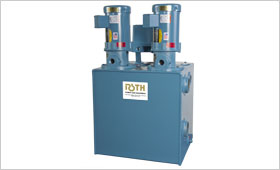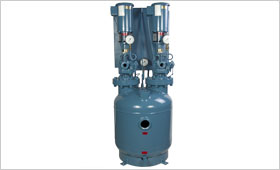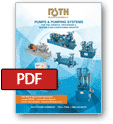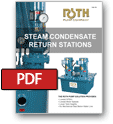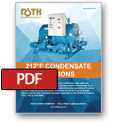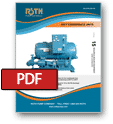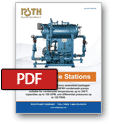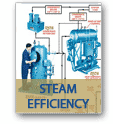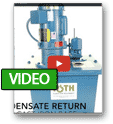Steam Condensate Pumps & Return Station Solutions
Roth Pump Company offers a variety of steam condensate pump return stations for improving the operation and efficiency of heating systems. In most heating systems, condensate, and sometimes steam, is trapped out of heaters, kettles, hot presses, molds, absorbers, and other equipment and drained to a return unit having given up some of its heat in the process. If a trap malfunctions, the condensate can be passed to the return unit at a much higher temperature causing the return unit to fail. When using Roth steam condensate pump return stations as the return unit, this problem is overcome because they are designed to eliminate cavitation at higher temperatures. In addition Roth steam condensate pump return stations are designed to handle the higher load placed on it during a cold start. Roth steam condensate pump return stations eliminate boiler system problems and continue to provide the efficient return of hot condensate to the boiler or feedwater system. Roth steam condensate pump return stations are supplied with reliable pumps that are designed to handle hotter water and develop higher pressures at lower speeds.
Roth steam condensate pump return stations are ideal for remote or non-accessible locations where unattended, dependable performance is essential. Roth Pump offers a variety of condensate return stations ranging from small efficient units to large, high temperature units for the most demanding applications.
Roth Pump Steam Condensate PUMP Advantages
- eliminate cavitation at high temperatures
- handle high load during cold starts
- dependable pumps to handle hotter water
- develop higher pressure at lower motor speeds
- proven engineered design
What is a steam condensate pump?
Steam condensate pumps are an essential component of steam heating systems, helping to ensure the efficient and effective transfer of condensate throughout the system. But what exactly is a steam condensate pump, and how does it work?
In simple terms, a steam condensate pump is a device that removes condensate, or water that has condensed from steam, from a steam heating system and returns it to the boiler. This process is crucial for the proper functioning of the steam system to operate efficiently.
The steam condensate pump works by using a pump to push the condensate through a piped system and back to the boiler. The pump typically consists of a receiver tank, a pump, and a level control system.The receiver tank is where the condensate collects before it is pumped back to the boiler. The tank is designed to hold a certain amount of condensate, and when it reaches a certain level, the pump is activated to transfer the condensate to the boiler.The pump itself uses an impeller to move the condensate through the system. The pump is powered by a motor and is controlled by a variety of floats or sensors that monitor the level of condensate in the receiver tank.The level control system is a critical component of the steam condensate pump, as it ensures that the pump is activated at the right time and in the right amount to maintain the proper level of condensate in the system. The control system can be a simple float switch or an advanced radar level controller for constant monitor of condensate levels.
Overall, the steam condensate pump is a vital component of any steam heating system, helping to ensure that the system operates efficiently and effectively. Regular maintenance and inspection of the pump can help to prevent problems and ensure that the system runs smoothly for years to come.
The main function of a steam condensate pump is to remove the condensate, or water that has condensed from steam, from a steam heating system and return it to the boiler. This is important for several reasons: Efficiency: Condensate buildup in the heating system can cause decreased efficiency and wasted energy. By removing the condensate and returning it to the boiler, the system can operate at maximum efficiency. Equipment protection: Condensate can cause corrosion and damage to the heating system's equipment, including pipes, valves, and fittings. By removing the condensate, the pump helps to protect the equipment and prolong its lifespan. Safety: Condensate buildup can lead to steam traps becoming blocked, which can cause dangerous pressure buildup in the system. By removing the condensate, the pump helps to maintain safe operating conditions. Overall, the steam condensate pump is a critical component of any steam heating system. It helps to ensure that the system operates efficiently and effectively, protects the equipment, and maintains safe operating conditions.
When should you use a steam condensate pump?
A steam condensate pump should be used in any steam heating system where there is condensate buildup. Here are some common situations where a steam condensate pump is necessary: Long steam lines: In systems where the steam lines are long, condensate can accumulate and cause decreased efficiency and equipment damage. A steam condensate pump can help remove the condensate and return it to the boiler, ensuring efficient and safe operation. High-pressure systems: In systems where the pressure is high, there is a greater risk of dangerous pressure buildup caused by blocked steam traps. A steam condensate pump can help prevent this by removing the condensate and maintaining safe operating conditions. Large systems: In systems with a high volume of condensate, a steam condensate pump can help remove the condensate more efficiently than relying on gravity alone. Systems with sensitive equipment: In systems with sensitive equipment, such as those used in the pharmaceutical or food industries, condensate buildup can cause contamination and damage. A steam condensate pump can help protect the equipment and maintain a safe and clean environment. A steam condensate pump should be used in any steam heating system where there is condensate buildup. The pump helps to ensure efficient and safe operation, protect equipment, and maintain a clean and safe environment in sensitive applications.
A steam condensate pump returns water to the boiler by using mechanical energy to move the condensate against gravity and back to the boiler feedwater tank or directly to the boiler. Here is a step-by-step overview of how a steam condensate pump works to return water to the boiler: Condensate collection: As steam flows through the heating system and gives off heat, it condenses back into water and collects in the system's collection points, such as steam traps or condensate return lines. Pump activation: When the level of condensate in the collection point reaches a certain point, the steam condensate pump activates, driven by electricity. Water intake: The pump draws in the condensate and moves it through the pump's impeller. The impeller increases the velocity and pressure of the condensate, helping to move it against gravity and back to the boiler. Water discharge: The condensate is discharged from the pump and returns to the boiler feedwater tank or directly to the boiler. The boiler feedwater tank allows for any remaining steam to be vented off before the condensate enters the boiler. Boiler operation: The condensate is then heated and converted back into steam, continuing the cycle of steam generation and heating. Overall, a steam condensate pump is a critical component of a steam heating system, helping to ensure efficient operation by returning water to the boiler and protecting the system from damage caused by condensate buildup.
How does a steam condensate pump return water to the boiler?
A steam condensate pump returns water to the boiler by using mechanical energy to move the condensate against gravity and back to the boiler feedwater tank or directly to the boiler. Here is a step-by-step overview of how a steam condensate pump works to return water to the boiler: Condensate collection: As steam flows through the heating system and gives off heat, it condenses back into water and collects in the system's collection points, such as steam traps or condensate return lines. Pump activation: When the level of condensate in the collection point reaches a certain point, the steam condensate pump activates, driven either by electricity or steam pressure. Water intake: The pump draws in the condensate and moves it through the pump's impeller or other moving parts. The impeller increases the velocity and pressure of the condensate, helping to move it against gravity and back to the boiler. Water discharge: The condensate is discharged from the pump and returns to the boiler feedwater tank or directly to the boiler. The boiler feedwater tank allows for any remaining steam to be vented off before the condensate enters the boiler. Boiler operation: The condensate is then heated and converted back into steam, continuing the cycle of steam generation and heating. A steam condensate pump is a critical component of a steam heating system, helping to ensure efficient operation by returning water to the boiler and protecting the system from damage caused by condensate buildup.
Technology
Overview
Roth Steam Condensate Pump Return Stations can be supplied for either simplex or duplex operation. Simplex units, ordered with larger receivers, can be converted to duplex operation in the field if an upgrade is required. Users can specify either cast iron or 3/16 inch (4.8 mm) steel receivers with receiver capacities ranging from 8 to 350 gallons (30 to 1325 liters). A safety reserve is provided in these capacities to handle water at up to 10psi (0.68 bar) above the selected discharge pressure. Safety venting to the atmosphere is standard.
Electrical equipment is generally mounted at least 1 foot (0.305 M) above floor level for safety and to maintain pumping if flooding occurs.
Roth units are supplied with an internal pump that operates at 1750 RPM. Pumps are leak proof and easy to maintain.
Floats are set at the factory to provide about 2 inches (5.08 cm) of water level variation between start and stop. This insures frequent recycling and smaller condensate transfers at higher temperatures, thus improving overall efficiency of the boiler system. If condensate is pumped directly to the boiler, this feature provides a more continuous flow.
Our standard float switch & mechanical alternator NEMA ratings include:
NEMA 1: Designed for use in indoor locations where the motor is protected from dust, dirt, oil, and dripping water.
NEMA 4: Designed for use in indoor or outdoor locations where the motor is exposed to splashing water, rain, snow, or hose-directed water.
NEMA 7: Designed for use in Class I, Division 1 hazardous locations, which involve the presence of flammable gases, vapors or liquids.
NEMA 9: Designed for use in Class II, Division 1 hazardous locations, which involve the presence of combustible dust.
Settings for both float switches and mechanical alternators can be field adjusted. All units can beprovided with optional pressure gauges for the pump discharge. An optional thermometer can be provided for the receiver.
Motor sizes range from 1/4 HP to 15 HP and operate at 1750 RPM. Operating voltages are 115/230 volt single phase or 230/460 volt three phase. Enclosed motors are available as an option.
Optional electrical equipment supplied with Roth Transfer Stations include starters, switches and/or alternators. All electrical equipment has been selected from electrical suppliers that have wide distribution and field service networks.
We offer a wide variety of motors for all protection types including all classifications of explosion proof motors to ensure your condensate system meets the appropriate electrical saftey requirements for the area.
Roth Pump Company is a U.L. Listed manufacturer of control panels. Underwriters Laboratories Listed Industrial Control Panels are available on request.

